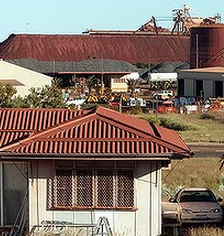
From The Australian:
The eye-watering rents in the dusty iron ore town of Port Hedland that once made international headlines — and which had proved cash cows for their owners — are suddenly plummeting.
This latest property report from the state government’s Pilbara Development Commission, released last week, showed a clear downturn in the region’s once booming rental market.
In Port Hedland and South Hedland, the number of properties available for rent jumped 37 per cent during the June quarter to 401, the highest figure on record.
Rents in Karratha have now fallen for seven straight quarters, with the average advertised rent shedding almost $500 a week to sit at $1285 a week — again, the lowest figure since the commission began compiling the data.
It’s a similar story in West Perth, the leafy enclave that is home to hundreds of small mining and exploration companies and the contractors and consultants who service them. Office vacancies there have gone from all but non-existent to their highest levels in almost two decades.
According to Y Research, the vacancy rate in West Perth is now at 11.3 per cent, a level not seen in 18 years. A year ago the rate was 3.3 per cent, which made it the tightest non-CBD market in the nation.
John Poynton, executive chairman of Perth-based investment bank Azure Capital, describes the current environment as a “mixed bag”…”I was at Rockpool the other night on a Tuesday. It was full.”
Err, can I suggest that Rockpool is hardly a gauge of what happening in the broader economy? Anyway, I agree that it is a mixed bag right now. Perth housing rents are looking toppy but have not rolled over like the mining towns. The oil and gas sector still has the Gorgon and Wheatstone projects underway. With a combined spend of $81 billion, they begin pumping in early 2015 and 2016 respectively. But, according to our own special report on the subject:
However, there are reasons to think that the LNG boom will only mitigate and not prevent downside risks for the WA economy. LNG has far fewer local multiplier effects than traditional mineral ore mining, largely because much of the equipment and expertise is imported. This is why the Barnett government is currently fighting a rear-guard action against the shift towards floating LNG projects (in which mining and processing is all done on huge ships). Take away the construction jobs available in onshore processing and there’s isn’t a lot of local benefit left beyond a boost to taxes.
Moreover, the two mega-projects’ combined spending is already close to or past its peak, also withdrawing from growth in the near future and increasing the negative multiplier effects as well as putting more pressure on the labour market.
The entry of cheaper US LNG into the Pacific Rim market means no new LNG projects will be approved.
It’s the last two points that matter for WA. This was an enormous boom. And it has brought on enormous supply. With no new projects, the decline of LNG investment will slow but not prevent a WA bust across all sorts of markets.
We are only at the leading edge of a very long and increasingly steep slope as the heat on iron ore rises all of next year and LNG wanes.
For more and to understand the implications for WA property, subscribe to our members report. Sign up here. And get the report here once signed up and logged in.

